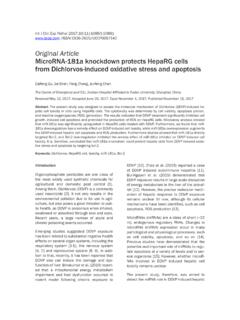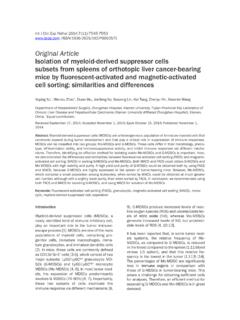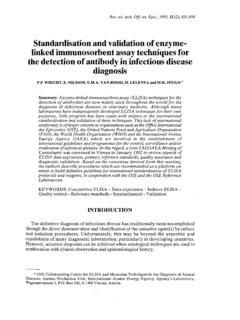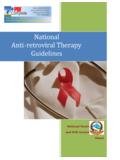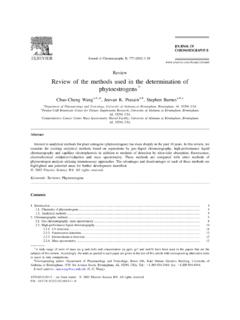Transcription of Original Article Evaluation of a high avidity anti …
1 Introduction The presence of anti - dsdna IgG antibodies is considered diagnostic of systemic lupus erythe-matosus (SLE), an autoimmune disorder that is characterized by chronic inflammation and pro-duction of several autoantibodies [1-3]. anti - dsdna antibodies can be detected by a variety of test systems the most common of which in-clude, enzyme-linked immunosorbent assay (ELISA), Crithidia luciliae immunofluorescence test (CLIFT) and the Farr radioimmunoassay (RIA) that is based on the ammonium sulfate precipitation of immune complexes [2-10]. These antibodies are heterogeneous with re-spect to avidity , class, cross-reactivity and clini-cal relevance. It has long been established that the analytical principle of the anti - dsdna IgG antibody assay determines both its diagnostic and predictive capabilities in SLE [2, 4, 6-10].
2 High avidity anti - dsdna antibodies as detected by CLIFT and/or Farr assays have been reported to have good positive predictive values for SLE while ELISAs have largely been reserved as screening tools [2, 5-6]. There are several evidences that point to SLE as an immune-complex disease in which inflamma-tory processes are initiated by local deposition of DNA or anti - dsdna complexes. In this regard, some reports indicate that changes in the level of anti - dsdna in an individual patient may pro-vide clues to a patient s disease status in rela-tionship to active disease or remission. Indeed, it has been reported that levels of anti - dsdna antibodies in serum tend to reflect disease ac-tivity but not in all patients [11].
3 In patients who have both elevated levels of anti - dsdna autoan-Int J Clin Exp Pathol 2011;4(8):748-754 /IJCEP1109010 Original Article Evaluation of a high avidity anti - dsdna IgG enzyme-linked immunosorbent assay for the diagnosis of systemic lupus erythematosus Brenda B Suh-Lailam1, Tyson R Chiaro1, Wayne Davis K1, Andrew R Wilson1, Anne E Tebo1,2 1 ARUP Institute for Clinical and Experimental Pathology, Salt Lake City, UT, United States; 2 Department of Pathology, University of Utah School of Medicine, Salt Lake City, UT, USA Received September 27, 2011; accepted October 29, 2011; Epub October 30, 2011; Published November 31, 2011 Abstract: The high avidity (HA) anti - dsdna IgG ELISA is considered highly specific for the diagnosis of systemic lupus erythematosus (SLE).
4 The main objective of this study was to determine the performance of this test with existing assays for detecting anti - dsdna IgG antibodies as well as assess its analytical characteristics. For method compari-son studies, we investigated the correlation between the HA ELISA with 8 other assays for the detection of dsdna IgG antibodies namely; six anti - dsdna IgG ELISA, the Crithidia luciliae immunofluorescence test (CLIFT) and an in-house developed Farr radioimmunoassay (RIA). Overall, 125 patient (100 ANA-positive, 25 CLIFT-tested) and 100 healthy control samples were tested. The assay was also evaluated for imprecision, lot-to-lot consistency and the effect of interfering substances using commercial quality control materials based on the manufacturer s claims unless other-wise stated.
5 Of the 100 ANA positive samples, 18 were positive in the HA ELISA with significant levels of antibodies in the six ELISAs and CLIFT. The HA ELISA had a specificity of 100% with an overall agreement of 84% with the RIA. Intra- and inter-assay imprecision ranged from and the reproducibility between lots based on qualitative inter-pretation was 100%. Hemoglobin, bilirubin and lipemia showed variable interference with assay performance based on the manufacturer s claims and our in-house protocol. Our data suggest that the HA ELISA although less sensitive than the other dsdna IgG assays evaluated, is specific and predicts high levels of anti - dsdna IgG antibodies . Keywords: Performance, agreement, imprecision, anti - dsdna , antibodies High avidity anti - dsdna IgG 749 Int J Clin Exp Pathol 2011;4(8):748-754 tibodies and clinically quiescent disease, 80% have disease that becomes clinically active within 5 years after the detection of elevated levels of these antibodies [12].
6 In addition, high avidity anti - dsdna antibodies are more closely associated with renal involvement and/or dis-ease activity than intermediate or low-affinity anti - dsdna antibodies [11, 13, 15-19]. A high avidity (HA) anti - dsdna IgG ELISA (INOVA Diagnostics, San Diego, USA) formerly referred to as the FARRYZME high avidity anti - dsdna IgG assay (The Binding Site, Birmingham UK) is de-signed to detect high avidity anti - dsdna IgG antibodies [14-16]. Based on the ammonium sulphate precipitation of the dsdna antigen, the principle of the HA ELISA is thought to be similar to that of the Farr radioimmunoassay with the advantage that no radioactive substance is em-ployed. This study was designed to evaluate the analytical concordance of this HA ELISA with six commercially available ELISAs, the CLIFT and in-house developed Farr RIA for detecting anti - dsdna IgG antibodies .
7 The assay was also in-vestigated for imprecision as well as the effect of interfering substances on test performance. Materials and methods For this study, we used 100 anti -nuclear anti -body (ANA) positive sera with a homogeneous pattern and titers 1:160 by indirect im-munofluorescence assay (IFA) on HEp-2 cells and 100 adult healthy control (HC) samples as previously described [20]. To determine cor-relation between the Farr radioimmunoassay (RIA) and HA ELISA, 10 negative (<1:10) and 15 positive ( 1:10) previously tested specimens by CLIFT were evaluated. For the method compari-son studies, all 100 ANA positive and 100 healthy control samples were screened for the presence of anti - dsdna IgG antibodies using six commercial ELISAs from AESKU Diagnostics, The Binding Site (TBS), Bio-Rad Laboratories, Euroimmun, Dr.
8 Fooke Laboratories, and INOVA Diagnostics, CLIFT (INOVA) and HA ELISA (INOVA) according to manufacturers guidelines. To determine the correlation between the HA ELISA and Farr RIA, 25 previously tested speci-mens by CLIFT were identified and referred to Quest Diagnostics (Valencia, CA) for testing us-ing their in-house developed assay. To evaluate the analytical performance of the HA ELISA; lot-to-lot variation, imprecision, and interference studies were performed. For the determination of lot-to-to variation, 25 previ-ously tested samples by CLIFT were tested with two distinct lots of the HA ELISA kits. Impreci-sion studies were performed with three sam-ples; one negative, one low positive and one high positive which showed consistent results between the two lots.
9 All three samples were stored at 4 degrees Celsius (4 C) until used. Samples were tested twice a day in triplicate, with a minimum of 2 hours separating each run for three consecutive days. The resulting data was used to calculate between (inter) and within-run (intra) CVs. For the interference studies, we employed previously tested specimens which were either negative, low positive or high posi-tive in both lots of the HA ELISA. These samples were supplemented with various concentrations of hemoglobin (486 mg/dL), bilirubin ( mg/dL) or lipemia (2000 and 1000 mg/dL) accord-ing to manufacturer s recommendation or our in-house protocol. Spiked pools were tested in triplicate by the HA ELISA and a deviation of more than 10% from the target concentration was considered to be a significant interference.
10 For statistical analyses, manufacturers sug-gested cut-offs were applied to create positive and negative values from the continuous origi-nal observations. Positivity rates, specificities and Spearman correlation coefficient between assays were calculated as indicated using SAS software, Version of the SAS system for Win-dows. Copyright 2002-2008 SAS institute Inc., NC, USA. The percent agreements between the assays investigated and HA ELISA were calcu-lated with HA as reference test, unless where indicated. All other calculations were performed using Excel. Results To evaluate the performance characteristics of the newly developed high avidity anti - dsdna IgG ELISA, we first compared its agreement with 7 other tests for the detection of this analyte in 100 ANA IFA positive sera which had a homoge-neous pattern and titers greater than or equal to 1:160.



